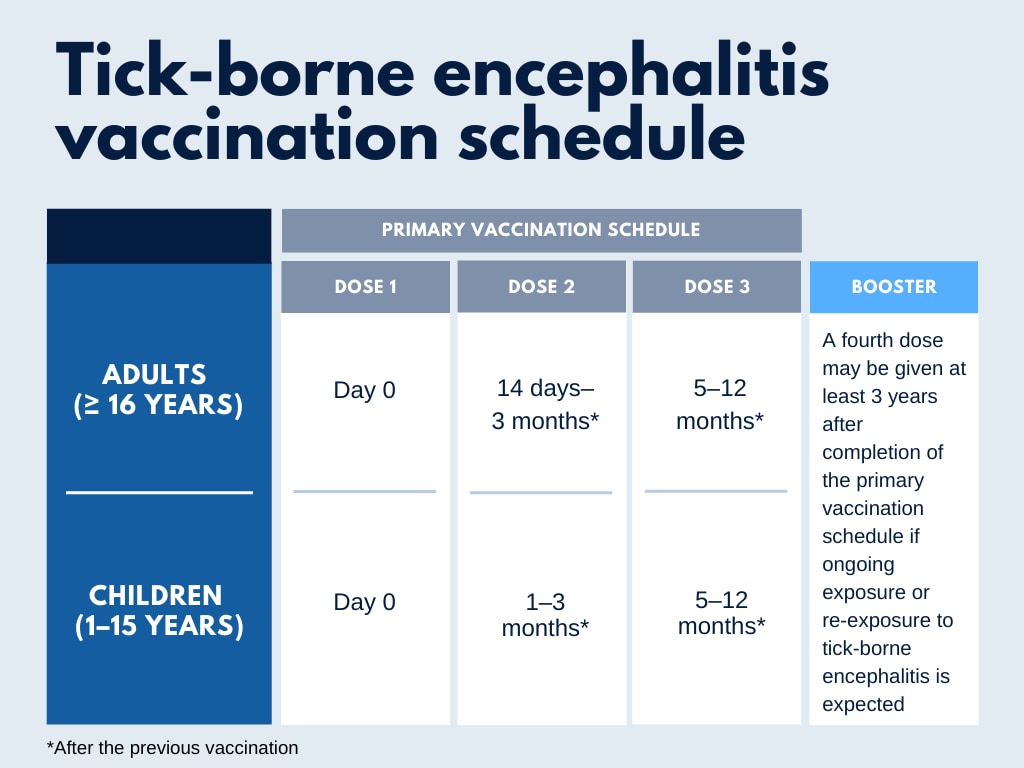Vaccine
Advisory Committee on Immunization Practices (ACIP) recommendations for tick-borne encephalitis (TBE) vaccine
TBE vaccine is recommended for persons who are moving or traveling to a TBE-endemic area and will have extensive exposure to ticks based on their planned outdoor activities and itinerary.
In addition, TBE vaccine may be considered for persons traveling or moving to a TBE-endemic area who might engage in outdoor activities in areas ticks are likely to be found. The decision to vaccinate should be based on an assessment of their planned activities and itinerary, risk factors for a poorer medical outcome, and personal perception and tolerance of risk.
In August 2021, the FDA approved a TBE vaccine, TICOVAC (manufactured by Pfizer), for individuals aged 1 year or older. The dose for persons aged 16 years and older is 0.5mL, and for children and adolescents up to 15 years of age is 0.25mL. The primary vaccination schedule includes 3 doses, and a booster dose can be given if ongoing exposure or re-exposure to TBE virus is expected. TBE vaccines are also available in many countries overseas where TBE virus is present.
In February 2022, the U.S. Advisory Committee on Immunization Practices approved recommendations for use of vaccine among persons who travel abroad and for laboratory workers in the United States.
Risk Factors for TBE Virus Infection Among Travelers
The risk for TBE for most U.S. travelers visiting TBE-endemic areas is very low. However, some people who travel abroad are at increased risk for infection based on travel season, location, activities, and duration. Detailed information on factors that increase risk can be found below. Key factors include:
- Traveling during the warmer spring and summer months.
- Participating in certain recreational outdoor activities (e.g., hiking, camping, hunting, fishing) in tick habitats in or on the edges of forests.
- Working in outdoor settings where there is an increased risk of coming into contact with infected ticks (e.g., forestry workers, farmers, military personnel, researcher undertaking field work).
- Staying for longer periods or repeated travel to endemic areas (which might increase the likelihood of exposure to TBE virus), although activities undertaken are more important than time spent abroad.
Vaccine Considerations
All persons who travel to TBE-endemic areas should be advised to take precautions to avoid tick bites. TBE vaccine can further reduce the risk for infection and might be indicated for some persons at increased risk for TBE. The risk-benefit assessment for vaccination should include several factors:
- Likelihood of exposure to TBE virus-infected ticks based on activities and itinerary (e.g., location, rurality, season, and duration of travel or residence). Persons with extensive exposure to ticks are likely to be at highest risk and could include shorter-term (e.g., <1 month) travelers with daily or frequent exposure, or longer-term travelers with regular (e.g., a few times a month) exposure, to environments that might harbor infected ticks;
- Rare occurrence of TBE but its potentially high morbidity and mortality;
- Higher risk of severe disease among certain individuals (e.g., older persons);
- Availability of a vaccine with a good long-term immunogenicity and safety profile;
- Possibility but low probability of serious adverse events after vaccination, like any vaccine;
- Likelihood of future travel to TBE-endemic areas;
- Individual’s personal perception and tolerance of risk for a potentially severe disease.
Available data from human and animal studies, and the genetic and antigenic similarity between the three subtypes of TBE virus, suggest that the TBE vaccine (based on a European TBE virus) provides protection against the other main subtypes, but data are limited, and vaccine effectiveness has not been demonstrated.
Decision-making for tick-borne encephalitis (TBE) vaccination for U.S. travelers [PDF – 1 page]
Factors that increase the risk for TBE among travelers
Season
- TBE virus transmission occurs primarily during the warmer months from April through November when ticks are most active.
Location
- TBE virus transmission occurs within focal areas of countries in a geographic region extending from western and northern Europe through to northern and eastern Asia;
- Country-specific risk information is available here; the information should be interpreted cautiously because TBE virus transmission can be highly variable within risk areas and from year to year;
- Ticks are typically found in woodland habitats including in deciduous and coniferous forests and in the transition zone between forests and grasslands.
Activities and occupations
- Examples of some recreational activities that can increase the risk of exposure to ticks include hiking, camping, cycling, hunting, fishing, bird-watching, and collecting mushrooms, flowers, or berries;
- Occupational risk might exist for those with exposure to ticks such as forestry workers, farmers, military personnel, or researchers undertaking field work in rural areas;
- TBE virus transmission can occur if persons ingest unpasteurized milk and milk products from infected goats, cattle, or sheep.
Duration
- Activities undertaken are more important than time spent abroad, and TBE cases among U.S. travelers have occurred following short-term travel; however, a longer duration of travel, residence, or repeated travel to endemic areas might increase the likelihood of exposure to TBE virus.
Other considerations
- Older persons with TBE have a higher risk of a poorer outcome than younger persons;
- Persons with altered immunocompetence can have severe TBE and have a higher risk of a fatal outcome; however, immunocompromise and immunosuppression are precautions for vaccination.
